Create a lasting impression
Editor's note: Amy Shea is brand experience director at Ameritest, an Albuquerque, N.M., research firm. Based in Chicago, Emily Higgins is vice president of client services at Ameritest.
“The human brain . . . just think about this problem for a second. Here is a lump of flesh, about three pounds, which you can hold in the palm of your hand. But it can contemplate the vastness of interstellar space.”
– Vilayanur Ramachandran, neuroscientist
You don’t often think about your brain. You use your brain to think about everything else but that “lump of flesh” doing the thinking. And that’s how it should be most of the time, at least for us non-neuroscientists.
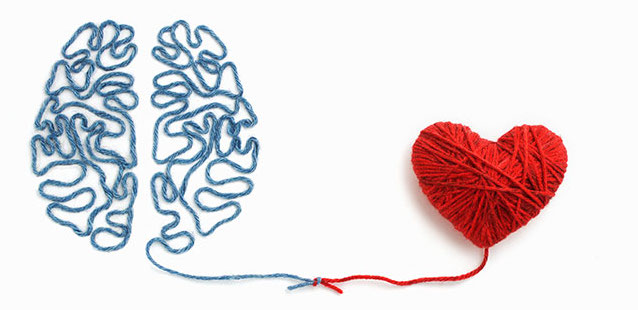
But for now, let’s do think about why thinking should matter so much to brands. Because as we go through our days, living our lives, we’re all also collectors, unconsciously picking and sorting through a barrage of stimuli that we are taking in beneath our awareness: images, sensations and emotions that swirl around us in endless supply. And what gets sorted to be attended to – the brain activity that brings something to our awareness – should matter to brands. A lot.
So, what are we sorting for, exactly? And, when we get it, what do we do with it?
The first question is a bit easier to answer than the second.
In short, we are sorting for what has meaning to us. The brain is programmed to search for intention. Are you friend or foe? Is this thing in front of me happy, harmless or hurtful? We are, in essence, sorting for what will keep us alive in the most pleasurable way possible.
There is a reason evidence of storytelling exists from before written language. Stories are, as screenwriting teacher Robert McKee says, “equipment for living.” They need not be grand or epic. They can be the simple narrative of what happens when the central character puts her hand into a fire and is burned. An inciting incident of inserting a hand into flames leads to the story’s painful climax and closes with the denouement of attempts at repair. While hardly Gone with the Wind, it is one of the very first stories we learn. And, importantly, it is a story we keep.
Why? The question may seem absurd at first but behind it is the brilliant way the human brain works. We keep the story because it guides our decision-making – what our intention should be to get the thing we want. A very important thing we want is to stay safe. So we store a narrative about fire as a memory. And far from something that fades away in a mental dustbin, it is always there at the ready to guide our decisions in those beach bonfire and BBQ moments.
This simple concept is incredibly complex because we keep countless stories in our memories. They were put there, unconsciously, by us. And their entire purpose is to help us make decisions in the present that impact our future.
We don’t keep them because we’re sentimental or we simply want to; we keep memories because our minds think we need to. Some, like avoiding contact with fire, feel instinctual to us as adults. But we learned it, as any parent of a young toddler can attest to. And this is the purpose of memory. Memory is there to help us choose. Daniel Kahneman in his now-famous book Thinking Fast and Slow refers to this decision maker as the remembering self. And as he says, “The remembering self may be wrong, but it is the one that makes decisions.”
And that is why brands should care. It’s the remembering self that choses what to buy the majority of the time, among other decisions. Impulse buying may work for the occasional lipstick, because the stakes are so low that memory just gives you the side-eye and lets it slide; it remembers that this is harmless and even fun. But don’t try to buy a sportscar without memory bringing up that credit card mess you got yourself into last time and the pain it inflicted with its consequences. You may end up creating a highly-fictionalized narrative in your head that justifies why the car should be yours but you will call on a “sense-making” narrative and not simply emotional response.
So why is so much attention given to emotion? Because emotions remain the most powerful motivator when it comes to decision-making. They are absolutely the captain on Team Memory. There are three memory systems that weigh in when it comes to making a choice. And the more that brands understand how memory works and can unpack its sorting process, the more likely the brand will be kept as a branded memory and be chosen.
Three distinct aspects of the brain
The race to stop the devastation of Alzheimer’s disease has led us to a deeper understanding of how memory actually works. Scientists now understand that there are three distinct aspects of the brain that collaborate on the creation of memories and we have a much deeper knowledge than in the past of how they operate.
These three systems the brain employs in the job of memory-making are best described by what they actually do. They are referred to by academics as semantic, episodic and procedural.
Semantic memory is the place where concepts live, such as 1 + 1 = 2 and all the stories that teach us about how life works and its causes and effects – such as what can happen to if you stick your hand in a fire. This is the part of memory that requires cohesion and meaning and nothing gets in its way like confusion. When faced with a confusing story we either struggle to make it make sense because it’s important or we abandon it, especially if it’s a very unimportant thing called an ad.
Episodic memory is personal and emotional; it’s your memory of where you were on 9/11 or when Obama was elected or when Princess Diana passed away. It’s an “episode” that happened in your life story. Even if it physically happened to someone else, it also happened to you and carries emotional information that can be accessed. When these personal episodes are linked to a cohesive and relevant narrative, the emotions are magnified by the narrative’s meaning. We have all had this experience watching a film with a story that has us so engaged that we literally feel the emotions by an order of magnitude.
Procedural memory is how you know how to drive a car or drink a glass of water without thinking about it anymore – skills that once upon a time had to be rehearsed with a great deal of cognitive strain. We now know that there are actually things called mirror neurons in the brain whose job it is to rehearse actions we see and experience them the same way we do if we were doing them ourselves. Effectively rehearsing emotionally meaningful experiences in a clear and relevant narrative is a winning trifecta in branded communications.
Another way to think about these three memory systems in the context of communications is head (semantic), heart (episodic) and hand (procedural). Head, heart and hand gives us and our brand and agency partners an intuitive way to describe how memory works when it comes to a brand’s communication strategy.
Impact it can have
We recently conducted a case study, one that was not client-specific, which allows us to explore the kind of insights that branded memory research delivers and the impact it can have on a brand’s strategy. The two-phase study looked at the casual-dining category (CDR) and though we won’t be addressing the other categories in the study here, we also included the fast-casual dining and family-dining categories in order to identify what was unique to the CDR category.
This study was done in two phases because we needed first to identify the most powerful story in the category (the head) and what emotions are triggered by the category (the heart). Until we have the story and the right emotions identified, we cannot source a comprehensive selection of images that will help us identify the visual language that will align and act as a powerful rehearsal for the viewer (the hand).
We used attribute/benefit/value metrics to get at story and rapid-choice responses to get at emotions in Phase 1; in Phase 2 we used visuals to interrogate the rehearsal of the CDR experience. A quantitative online study of 800 CDR diners was conducted in August 2018.
Let’s look at the research through the three lenses of head, heart and hand and how they illuminate the building of branded memories.
Phase 1
Head
Understanding the story that is currently carried by consumers in a category and for a brand – and the more powerful story that could be created – all starts with a carefully selected set of ratings. These ratings must give us inputs for the following equation: What does the category/brand do (attributes) and what do I get from that (benefits) and why do those benefits matter (values)?
We call this the ABV equation and in order to identify it, the five-point agreement-scale ratings must be balanced across category attributes, benefits and values. When balanced correctly, they can combine into myriad combinations that are not linked directly by the respondent but linked indirectly through a pathway analysis. This indirect analysis is critical, as consumers are unable to articulate this information, much less tell us what is more or less important.
The pathway analysis, however, delivers possible ABV equations that need to be further winnowed to find a true hierarchy of what equations will be most powerful in the category. The initial seven possibilities were then also examined through the lens of the strongest emotions in the category – coming up next in this article. And, thirdly, a regression was done where we analyzed what having a preference for the CDR category (over other kinds of dining) was most dependent upon.
When we finished our tri-level analysis from the Phase 1 data we had three ABV equations. We found the story currently carried was, not surprisingly, a cost of entry for this kind of dining: A variety of affordable, crave-able food that tastes great.
The first thing to notice about this statement is what’s not there. The attributes of crave-able and affordable food create a benefit of delivering great taste but the story ends there, with the benefit but without a value connected to it. The benefit has a very basic and implied human value: great taste is pleasurable. It’s pleasurable and satisfying for human beings to eat food that tastes good and doesn’t cause them financial pain.
This lack of any value beyond how humans respond at a basic level to food is the double-edged sword of any cost-of-entry ABV equation. Yes, it triggers our salivary glands to see a burger on our big screens but the response is identified far more to the burger than it is to the restaurant putting it on offer. This story carried by consumers indicates that indeed they want this. But the story a category brand needs to tell includes this and then goes beyond it to create a unique branded story that drives restaurant choice.
In the CDR category, two such story equations emerged, on-par for power to move the CDR consumer. We call these experience discriminators – a true level up from cost-of-entry.
- They make me feel welcome (attribute), so we can be ourselves (benefit) and enjoy family time (value).
- The restaurant has a fun atmosphere (attribute), where I can celebrate without going broke (benefit) and break up the work week with some fun (value).
These two stories equate to strategic brand positionings that can be powerfully expressed. However, these positionings alone will not tell a brand struggling to thrive in a highly competitive environment what emotions to leverage. Without emotional resonance, the strongest contributor to choice is not being strategically employed.
Heart
Too often brands seek emotional insights and get nothing more than a collection of words that are both highly filtered by the conscious mind and quite vague. This gives client partners something else to worry about without giving them the power to address it.
We conducted the emotional aspect of this study with our collaborative partner, Todd Powers, who has worked to examine emotions in order to help brands create an actionable emotional strategy – one that captures latent emotions. The methodology, now called the Rational Heart, is a timed, rapid-choice System 1 approach to an established system of emotional measurement developed by Robert Plutchick of the Einstein School of Medicine.1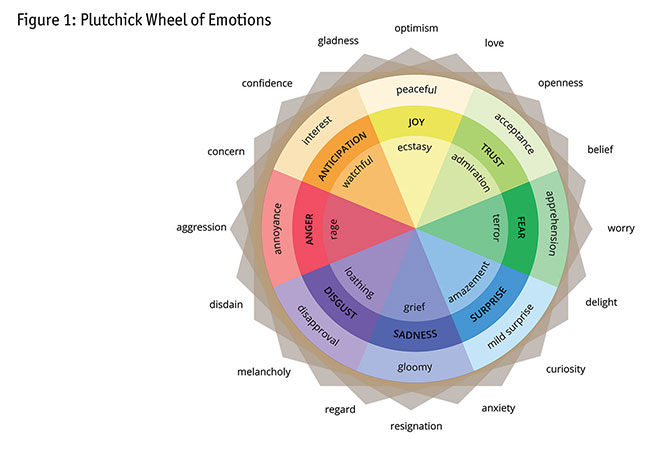
Many of you will recognize this model of emotions pictured in Figure 1. Plutchick created a systematic classification of emotions that shows the eight basic emotions that most of us are familiar with and expands those eight to demonstrate that they have levels of intensity. He also studied and tested how they combined to create the more nuanced and complex feelings that we all experience and use when we talk about our feelings. It’s those combinations that Powers’ system expanded upon and now uses with us in the brand space.
In our collaborative research with Powers using the Rational Heart we used the rapid-choice exercise to get at the key emotions in the CDR category, without the conscious mind stepping in the way. The emotions driving this category are: curiosity, delight, love, joy and admiration.
Handing this list to a client would lead to a scramble to explain how these emotions have specific meaning in the category. That’s guessing and guessing can be disastrous for a brand that builds an entire strategic campaign around them.
Powers addresses this shortcoming of emotional measurement by employing modeling and calculating the key emotions in real-time and in the same survey interrogating the respondent on how they think about those handful of emotions in a category context.
These open-ended responses are critical to giving category specificity to otherwise general language.
In the CDR category, the specific emotional meanings are: curiosity (about what I’ll discover); delight (at what good things await); love (the time I’m spending with friends and family); joy (at being free from cooking/cleaning chores); admiration (at how the chef and staff consistently deliver).
The more we work with branded memory, the more we see confirmed again and again that emotions are not the same as cognition. We know that in our own lives, yet it has taken time to get to the integrated measurement we have today of how humans really work.
Emotions do not line up neatly with the stories found in ABV equations, further emphasizing this separation of powers in people. However, just as with people, that does not mean they are destined to remain disconnected. As mentioned earlier, we used these powerhouse emotions to identify the strongest among the ABV equations. And we use the emotions again, in a very important way, as Phase 2 of our research will show.
Phase 2
Hand
Humans speak a language that towers over any other: visual. The challenge for research in translating visual language into verbal meaning has not been nearly the same obstacle for humans. Before we utter a word we are reading our parents’ faces and making our own. We have, in our brains, millions of cues – and not just about faces but about environments and crowds and individuals.
The assessments we make, as Malcolm Gladwell documented so brilliantly in his best-seller Blink, can lead us to wrong judgements and sometimes need scrutiny but they also save our lives by alerting us to danger and helping us form initial bonds of trust through facial expressions and the body language of others.
Nowhere else have brands put this language to better use than in advertising and, more recently, all the methods of branded communications, from online content to programming to messages. In our consultancy, reading the visual language spoken and understood by viewers as they look at branded communications is a central part of our analysis.
Coming out of Phase 1, we understood very important aspects of the CDR category: the most powerful experiences that underlie stories in the category as well as the cost of entry and CDR’s five strongest emotional levers. Then, we had to unite them with strong directions around the most telegraphic and impactful visual language for agency creatives to draw upon as they craft branded communications.
An important point to make here is that the goal is not to emerge from our branded memory research with a prescription for what images must be included in future advertising. The images that align with the ABV equations and the emotional levers are meant only as guideposts. They are intended for examination by the brand and its agency partner, looking at tone and action. They are not film direction. Casablanca and Eternal Sunshine of the Spotless Mind are both extraordinarily good movies about love and memory but they are hardly the same and we encourage our clients to use our visual language research as a starting point on the brand’s way to a unique and compelling visual rehearsal of the experience.
The second and final phase of this research allowed us to bring that physical rehearsal aspect we call “hand” to the cognitive and emotional findings. People don’t just learn through watching; the brain is physically able to rehearse us doing actions as we watch them. The relatively recent discovery of mirror neurons in the brain and scientists’ ability to watch what happens in the brain when we view someone taking an action has deepened our understanding of this phenomenon.
We can see now that a subset of the motor command neurons that fire when we reach for an apple – about 20 percent of them – will also fire when we’re watching someone else reach for an apple. The scientist who discovered this, Giacomo Rizzolatti, an Italian neurophysiologist who works at the University of Parma, called them mirror neurons. In essence, the brain is adopting the other person’s point-of-view, performing a kind of virtual reality simulation.
This has remarkable consequences for CDR brands that want to convey, through messaging, what a restaurant experience will be like.
In this phase of the research, we began by pulling in a mixture of images from both our visual database on the category and also non-category images that came up in an online search for the five emotions and the key words in the ABV equations. After narrowing them down in a focus group, we settled on 40 images for the total sample to evaluate. Then, each image was kept or eliminated, and sorted, according to four criteria:
- It had to elicit strong positive emotion on a five-point scale.
- Then, it had to stretch the category without causing a disconnect. In other words, still fit the category, but giving a new idea or feeling about it.
- It had to be found strongly resonant with the aspects of the three ABV equations we knew from Phase 1 were levers in the category.
- It had to resonate with our five most powerful category emotions.
This strict filtering process brings us a visual dictionary to use as a starting point for creating branded communications, by story and emotional positioning. It is meant to inform the brief, not dictate what the brief should be, nor what specific visuals it should contain. The aim is to provide a foundation that empowers the creative team but does not restrict them.
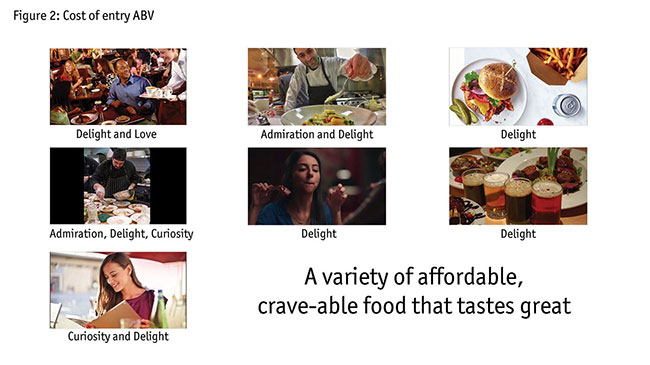 One of the most effective aspects of this approach to unpacking branded memory is that even the cost-of-entry positioning is heightened by bringing to bear an emotional lens. We can see in Figures 2, 3 and 4 that delicious food shown in a casual atmosphere telegraphs the important criteria of crave-ability, variety and affordability. However, we also see the powerful emotional levers at work, as love of family and friends, admiration of the quality preparation through the chef imagery and curiosity and delight are visualized.
One of the most effective aspects of this approach to unpacking branded memory is that even the cost-of-entry positioning is heightened by bringing to bear an emotional lens. We can see in Figures 2, 3 and 4 that delicious food shown in a casual atmosphere telegraphs the important criteria of crave-ability, variety and affordability. However, we also see the powerful emotional levers at work, as love of family and friends, admiration of the quality preparation through the chef imagery and curiosity and delight are visualized.
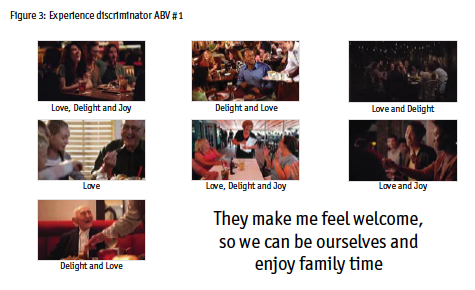
As we see, the joy of being free from the grind of chores enters into the visual lexicon with this powerful positioning, integrated into this story of welcome that signals “you can be yourselves and enjoy time together.”
While we did show imagery of clean kitchens, it was not nearly as powerful as showing people enjoying the benefit of the night out – indicating that the key idea of freedom from chores might be best tackled using voiceover while visualizing the stronger human-centric benefit. The diversity of people and their obvious happiness sends a strong message of welcome, comfort and the love that comes from time with friends and family.
Importantly, we see that a CDR brand can signal the powerful experience of family time while also covering cost-of-entry ideas like variety and delicious food.
In this equation in Figure 4, overt actions of having fun, including the restaurant staff, can help drive increased occasions for CDR brands. This ABV equation is, in its way, a natural extension of the warm, welcoming place where people can be themselves and experience the love of friends and family, as evidenced by repeating images here. This is good news for CDR brands that want to differentiate through experiences that drive choice but want to span both of these strongest positionings.
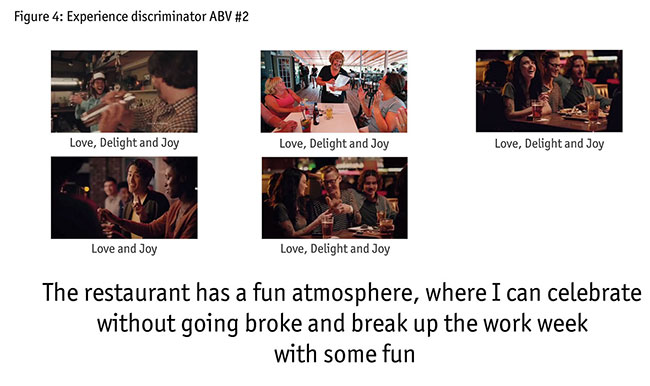
Not another set of buzzwords
The three aspects of memory are not simply another set of buzzwords; they are founded in an increasing understanding of the human mind, a complex and amazing experience we take for granted. As brands face the tall task of getting people to trade their precious attention for a brand promise, that promise must be a promise of the real: a story that resonates with a meaningful emotional value that allows rehearsal of the real experience.
To craft that story, brands need to use marketing research to:
- understand how attributes, benefits and values ladder up to the most powerful stories your brand can tell – a conceptual understanding that will release your story’s full emotional strength;
- understand the key emotional levers, both basic and subtle, and how they manifest in the category – and what your brand can own; and
- understand the most compelling visual language and then add creativity to allow your customer to rehearse the brand experience and want more.
If you are in marketing today, in any category, you are in the memory-making business. Choices in the present are made using memories as predictors of future experience. Understanding how to create branded communications that most effectively create memories is vital to success.
Reference
¹ Plutchick, Robert. https://positivepsychologyprogram.com/emotion-wheel/, retrieved January 15, 2019.
